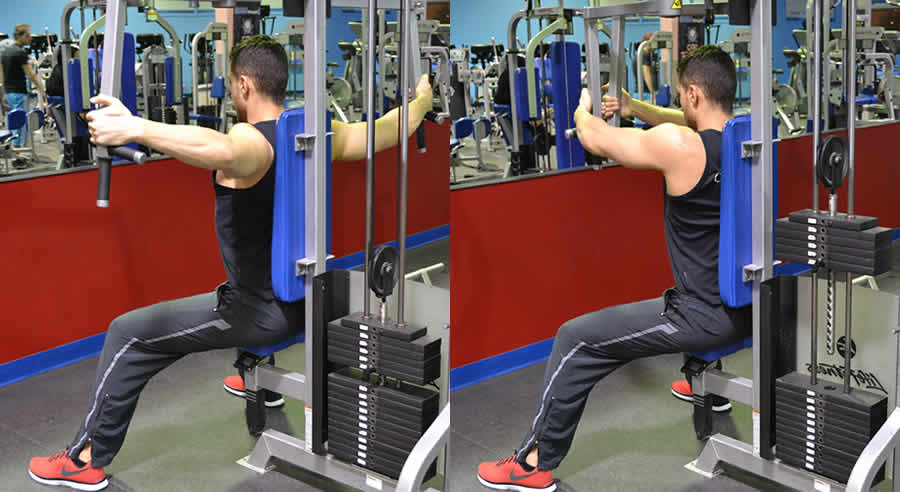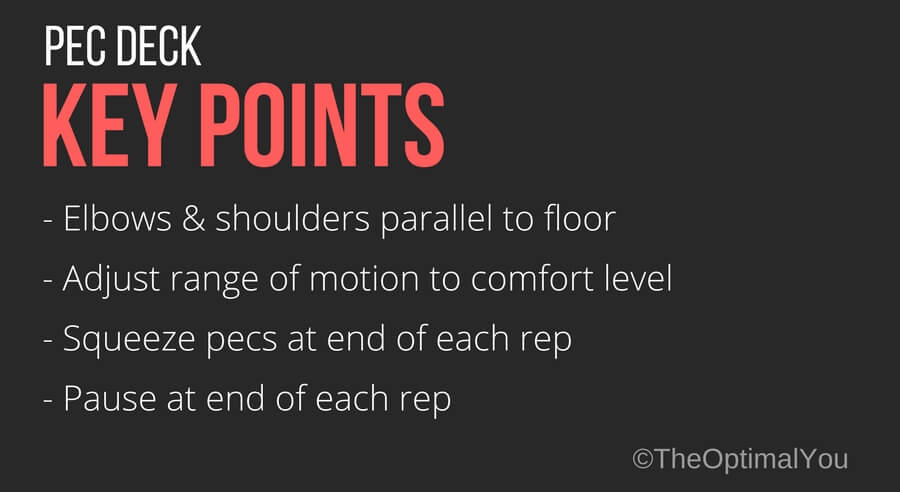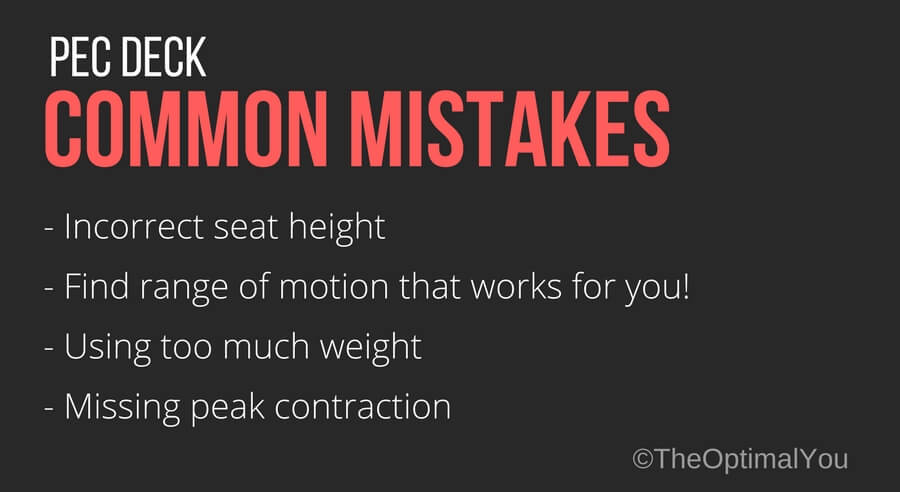Purpose of the Pec Deck
The pec deck is an isolated movement designed to target the chest, at the expense of the often involved front deltoids, and triceps. Although there is no such thing as a completely isolated movement, as other muscles besides the desired one will always be contributing to some degree, the pec-deck is as close to the most isolated movement you can do for the chest.
Equipment Needed for the Pec-Deck
The pec deck is a machine based exercise, and thus, a machine is required to perform this exercise – although there are alternatives that involve free-weights.
Difficulty of the pec-deck
On a scale of 1 to 5, the pec-deck would be classified as a 1, as it requires very little skill to perform. For this reason it is ideal for beginners, all the way to advanced trainees.
How to Perform Pec Deck
The primary adjustment needed to perform the pec deck appropriately is the height of the seat. You want the seat to be high enough, or low enough, so that your elbows and shoulders are aligned, and are both parallel with the floor – although you can adjust this based on personal preferences.
The other adjustment worth noting has to do with the range of motion. You have the option to limit the range of motion if your shoulder won’t permit you to go all the way back, so be sure to make that adjustment based on your personal dimensions, but understand that unless there’s a specific reason for doing so, full range is always best.
Once the machine is adjusted to your dimensions, and desired range of motion, begin by grabbing onto the handles with arms outstretched (slight bend in elbow is ok), and contract your pecs to bring the handles together in front of you – towards the midline of the body. Squeeze the pecs hard when the handles can no longer go any further, and slowly lower back down to the starting position. Pause at the bottom before beginning the next rep.
Key Points for the Pec Deck
- Adjust the height of the seat so your elbows and shoulders are parallel with the floor when holding the handles.
- Adjust the range of motion to allow you to train through your available range – as far as you can go without experiencing pain.
- Squeeze pecs at the end of the range.
- Pause at the end of each rep before initiating the next rep.
How Many Reps to Perform When Doing Pec Deck
Because the pec deck is an isolated movement for the chest, it doesn’t really lend itself to heavy lifting all that well. Because of this, it is best used for performing sets of 10-15 reps.
Common Mistakes when Using the Pec Deck
Some of the more common mistakes when performing the pec deck are:
- Not adjusting the seat to the right height – this can both limit the effectiveness of the exercise, and increase the risk of injury.
- Not adjusting the range of motion to what your body has available – one of the problems with machine based exercises is that people try to do the exercise through the range the machine has available, and not what their body has available. Always be sure to perform an exercise through the range of motion your body has available, NOT through the range the machine is capable of going through.
- Using too much weight – when you do this you are overcompensating with your shoulders
- Missing out on the peak contraction – the entire purpose of performing an isolation exercise like the pec-deck is to keep the desired muscle groups under constant tension. If you focus on lifting the weight, as opposed to contracting your muscles against resistance, you lose the effect that you set out to achieve by selecting this exercise in the first place.
Modifications to Pec Deck
The pec-deck is not limited to always having your upper arm parallel to the floor – you can grab the handles higher, or lower, to slightly emphasize different regions of the chest. You can adjust the seat based on the dimensions of your body, or just grab slightly higher, or lower, on the handles to do this. This is not a modification that would be necessary for beginners, but more advanced individuals intending to target very specific regions can make this adjustment if they feel they need to.
When to Perform Pec Deck
The pec-deck is a good exercise to use both at the beginning, or end, of a workout. The benefit to performing this exercise early on, is that it will promote the chest to be the limiting factor when performing other compound pressing movements in which smaller muscles like the triceps generally become a limiting factor first.
It is also a good option to use at the end of a workout to fully exhaust the chest, just in case more popular compound movements failed to do so – as a result of smaller muscles like the triceps becoming a limiting factor.
Alternatives to Pec-Deck
If you don’t have access to a pec-deck, but wish to isolate the chest, you can perform flat bench dumbbell flyes in which the only equipment necessary is a flat bench, and a pair of dumbbells (both of which most gyms have – in fact if a gym didn’t have these essentials, I would strongly suggest relocating to another facility).
Pec Deck vs. Flat Dumbbell Fly
The primary difference between the pec deck, and flat dumbbell fly, has to do with the amount of tension placed on the muscles. Biomechanically, flat bench dumbbell flyes place less, and less tension on the chest as the range of motion progresses. With the pec deck, the tension remains on the chest throughout the entirety of the movement.



